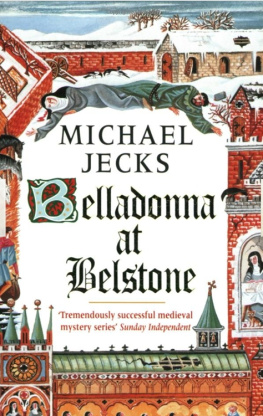Belladonna atBelstone
Michael Jecks
A WinterHorarium
Programme ofoffices to be held during winter months taken from Archbishop Lanfrancsschedule for the Benedictines of Canterbury. The times given are estimatesonly, for a small convent like St Marys would have had no accurate clocks.
At about 2.30 a.m.the nuns would all be roused from sleep and called to attend the choir of thechurch. Here they would sing psalms and offer prayers until the first of theservices, the Nocturns, after which the nuns would continue with Matins,which would be followed by Prime at dawn.
Once Prime was overthe nuns would go out and sit in the cloister, reading until about 8.00 a.m.when they would all return to their dorter, or bedchamber. Here they wouldchange their shoes, then go to the laver, where they would wash in preparationfor the next service.
Terce was followed by MorrowMass, after which the nuns would all go to their chapterhouse for theirdaily meeting. At this any admissions of failings or accusations of lapsescould be brought up, and apologies or penances offered or imposed.
Once the dailychapter had concluded, the nuns would spend their time either working orreading until noon. Then they would all go back to the church.
Sext, High Mass and None were allcelebrated, and at last the nuns could go to the frater for their only fullmeal of the day. This was followed by more work or studying until about 5 p.m.,at which they would return for Vespers in the church.
Vespers was thelast ceremony of the active day, and afterwards the choir would change intotheir night slippers and go to the frater to drink. In the medieval age peopledepended upon a diet which included much ale or wine, because the solid dietdid not provide enough essential vitamins or protein.
Finally the nunswould troop back to church to listen to a reading, and then would hear the lastservice: Compline.
After this, atbetween 6.30 and 7 p.m., the nuns should have gone to the dorter to sleep.
From the records,it seems clear that many did not.
AuthorsNote
The village ofBelstone sits high on the moors overlooking the deep valley that separates itfrom Cosdon, the massive hill that is visible from almost anywhere in northernDevon. I have known the area for years, for my brother and I visit it each NewYears Day, and walk with wives and families down south to the moors.
It was this year,1999, that we went to walk down towards the stream, and while strolling among aheavy clitter, I mused it was much like so many spots where monks and nuns choseto site their convents, an idle thought that eventually gave rise to thisstory. I invented St Marys.
Nowadays we thinkof abbeys and priories being set in delightful places, almost invariably amongtrees, with lush vegetation and parkland all around. Thats because since theDissolution, many have been converted into houses and gardens, their landscultivated over centuries. Beforehand they were often wild, remote, cold andbleak. Its true that in sunshine they are beautifully romantic ruins, but thatis because we visit them on holidays when the summer sun warms us and theancient nature of the wrecks can give us a comfortable sense of the passing ofthe years. Yet for all the delights of the larger ecclesiastical holdings atRievaulx, Westminster, York, Fountains and Whitby, many others sprang up anddisappeared, unable to support their communities with their poor and scrubbyland. The two years of famine (1315-17) speeded the end of some of these, asdid the two murrains or plagues, first of sheep (1313-17) and then of cattle(1319-21), which devastated the English economy. Smaller, less financiallyviable convents were swallowed up by wealthier ones. Some of these monasticbuildings can be traced on the ground, but their walls have been ravaged bytime and their stones removed by farmers who wouldnt pay for dressed stonewhen it was lying nearby. Many have simply vanished without trace.
When you look back,you find that the obedientiaries the nuns or monks - had a miserabletime of it. Woken for the first service at some time between midnight and 2.30a.m., they had to go to their church in their rough woollen clothing and standfor an hour or more in the freezing cold, trying to sound musical as they wentthrough the psalms and prayers. There was no fire nor any other means ofheating, and in the winter it must have been sheer hell. Not all convents couldafford glass in their windows, either.
That was part ofthe trouble: money. In the late 1200s there was a rapid increase in the numberof men and women taking up the religious life, and many convents started toaccumulate money from patrons so that they could expand, but many simplycouldnt: they didnt have the finance behind them. That was why in the early1300s many places, as I have outlined in this book, went to great lengths toacquire parish churches so that they could use the revenues. Some, like theconvent at Polsloe, greatly increased in size, but others failed to win themoney and faded away long before the Dissolution.
Nuns found it particularlydifficult to support themselves. The reason was simple: when a rich man died hewanted to ensure that his soul had as smooth a passage into heaven as possible,and to this end, he would set up a chantry. This was a chapel whichwas dedicated to honouring the dead man, holding services and praying for himevery day. Depending on how wealthy the man was, the more prayers he could buy;the more prayers said for him, so the logic went, the faster hed be let inthrough the Pearly Gates.
But there wereproblems for nuns: first, nunneries tended to depend upon the goodwill of theirstrong neighbours, and so they would sometimes agree to take in theirneighbours daughters in exchange for benefits, such as money, which inevitablyled to many of the convents having too many inmates for their means. The riskof over-filling nunneries was recognised at all levels within the Church, andnot only bishops but popes too sent letters to convents forbidding them to takeon any more nuns.
The second issuewas still more difficult to resolve. A man wishing to set up a chantry wantedservices held in his memory, but this was a time when no woman could hold areligious service, so nuns had to acquire their own priests, and what would bethe point of endowing a religious Order which couldnt even hold its ownceremonies? Men were more happy leaving their charities to male institutions:the force of monkish prayers was bound to have a greater impact than those of abunch of women!
Some readers may besurprised to see that I have created a priory with men and women, but this wasmore or less the norm. As I mentioned above, there had to be priests to conductservices, but also, although nuns were supposed to be completely hidden fromthe outside world and although they did have lay sisters to do the more mundanework like washing and ironing, they generally had to have men about the place.Men farmed; men tended the buildings; men saw to the religious services; menguarded the gates to the precincts. It was true that most of the nuns weresegregated and should never have been tempted by a male form, but that did notwork for them all. For one thing, the priorys bailiffs, reeves, receivers andother senior officials would have been men, and all had to report to theprioress. That was why it was not uncommon to hear rumours of improprietybetween prioress and her chief steward. They got to meet.
Tales of nunsmisbehaving are not new, and many such stories are no doubt apocryphal, but ithas to be accepted that some were true.
Young girls werethrown into their nunneries without any thought for them or their needs. Nodoubt some would have learned obedience, and in an age when women werepossessions to be used as their menfolk saw fit, perhaps some were content. Yetthis does not mean that all of them would have been happy with their lot, andrecords prove that many nuns were not chaste and a large number ran away. Thenun of Watton was not unique, and no, I didnt make up her story. Likewise thecollapsing of roofs was not unknown - at Morton the abbess allowed the churchroof and the roof of the dorter to fall in. Funds which should have been usedto repair them were squandered instead on Master Bryce, the vicar.
Next page








